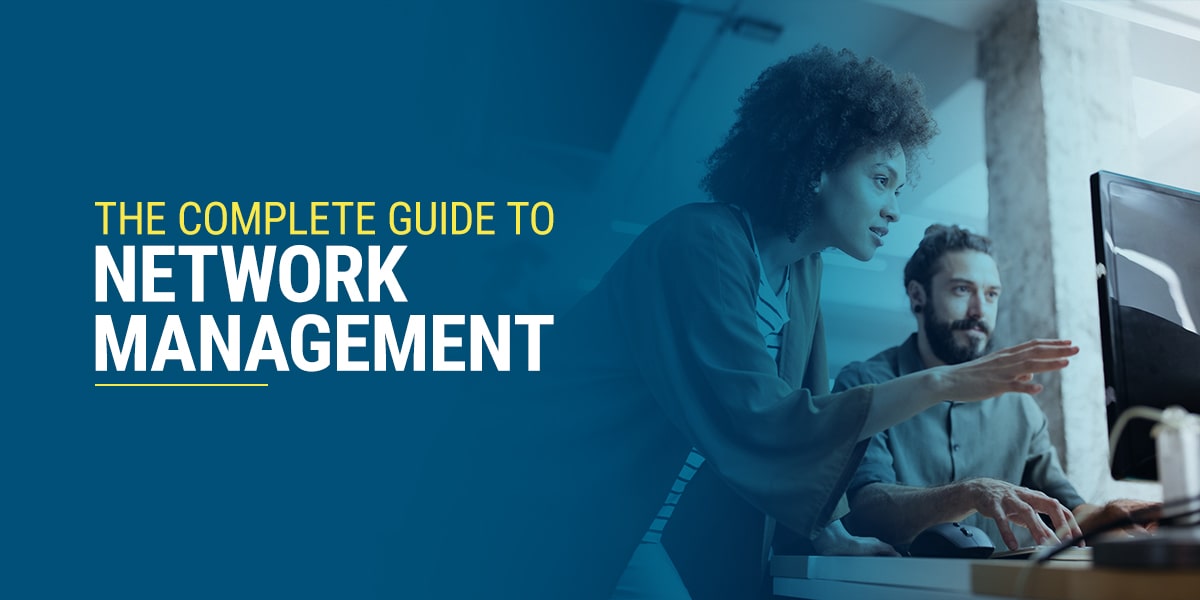
The Complete Guide To Network Management
As nearly every industry becomes more and more digitized and more and more reliant on internet connectivity, networks and network management continue to take on increased importance. Because of the complexity of network management, this is a specialized field that requires a considerable amount of knowledge, skill and troubleshooting ability.
Network management includes both hardware and software, and for some of the more complex systems, it can mean connecting very large, involved networks across different geographical locations. It’s understandable that network management may seem intimidating and overwhelming for people who do not have a background in IT. Nevertheless, for most professionals and small business owners, some level of network management ability will be crucial for both metaphorically securing your professional and financial future as well as literally securing your electronic data and information. There is no reason why anyone can’t learn about network management, the benefits and basic principles behind the practice, and the benefits of a network management system.

What is Network Management?
Essentially, network management refers to a practice of overseeing, monitoring and controlling all aspects of a computer/data network. In doing so, the network manager is able to ensure that all of the network’s components — both hardware and software — are running correctly, efficiently, productively and securely. In most cases, network management is administered by a person, usually a network manager or network administrator, and in some cases, a managed service provider (MSP). This individual or team of individuals is responsible for using the most up-to-date protocols, systems, applications and devices to collect and analyze network data. Using that data, the network manager can then create and push out network configuration demands that will increase productivity, keep up with business demands and ensure the reliability and security of the network.
Network management, then, is an incredibly important job that entails many different responsibilities. These responsibilities include the security of the network and its data and the productivity which the network allows, along with the overall user experience. To alleviate the complexity of this task, many businesses and companies choose to use a network management system, which essentially automates the primary task of network management.
Typically, a network management system comprises switches, routers, access points, and wireless controllers, which are all connected to a centralized server. The server itself can be either physical (on the premises of the business or located in a secure data center) or virtual (for example, located in the cloud). With the use of a network management system, clients, applications and devices can communicate directly with the server about their status. Network managers/administrators can then monitor the status of the network as a whole by connecting to the server. From the server, they can evaluate productivity and security and are able to troubleshoot as needed.
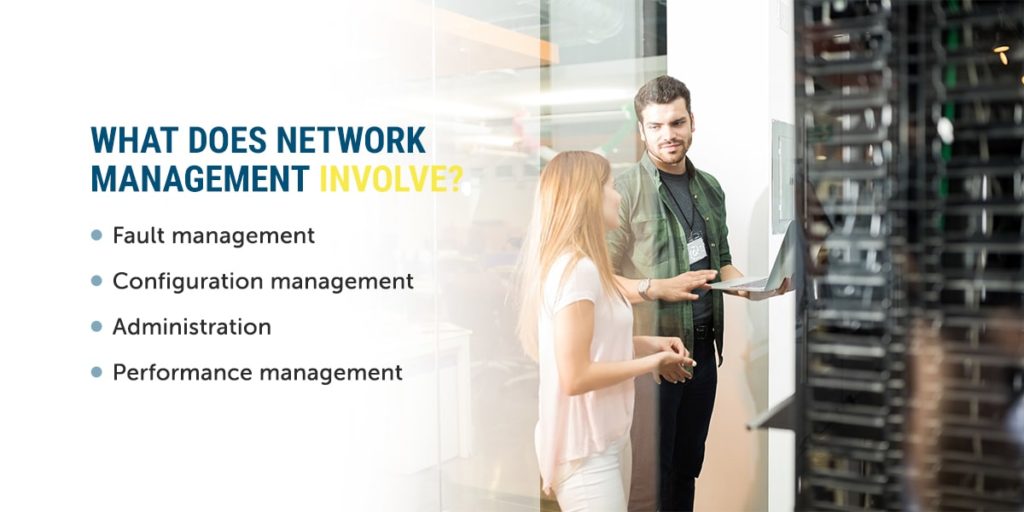
What Does Network Management Involve?
Network management, then, can be a highly involved and complex line of work. To better understand what network management entails, it can be helpful to use the acronym FCAPS, commonly used in the industry to describe the basic components of network management.
- Fault management. The “F” in FCAPS stands for “fault” and it is generally the most common and time-intensive aspect of network management. In network management, a fault — more commonly called an error or an issue — refers to any type of problem in the network that prevents the user from completing their desired task. When it comes to fault management, it is the network administrator’s responsibility to resolve the fault as quickly as possible. In most cases, a network administrator will first detect the problem, then isolate the issue and identify its cause(s). Then, the network administrator will use their knowledge and skills to troubleshoot until the process is resolved. Lastly, the network administrator will document the problem and the steps they took to address it.
- Configuration management. The “C” in FCAPS stands for “configuration.” In order for networks to work the way in which they are intended to work, they must be configured. Proper configuration dictates how devices on the network communicate with each other and with the server. There are a few different types of configurations that comprise a healthy network. Router and switch configurations store the network’s IP addresses and route settings, along with other information. Host configurations connect a device, like a laptop or desktop computer, to the network via logging the network settings. Software configuration allows for network-based software, such as Adobe, to access the network, connect to devices and monitor traffic.
- Administration. The “A” of FCAPS refers to “administration” and is another crucial component of network management. Network administration is one of the more clear-cut aspects of network management. In fact, it is in the title of network administrator. Some of the most common aspects of network management include setting passwords and granting permissions, along with general software security and data backups.
- Performance management. Lastly, the “P” of “FCAPS” stands for “performance management.” When it comes to performance management of a network, the network administrator uses metrics to monitor network performance and productivity, along with tracking any and all changes to the network itself. Collecting and analyzing data is crucial for establishing baseline performance for the network, as well as opportunities for improvement and increased capacity.
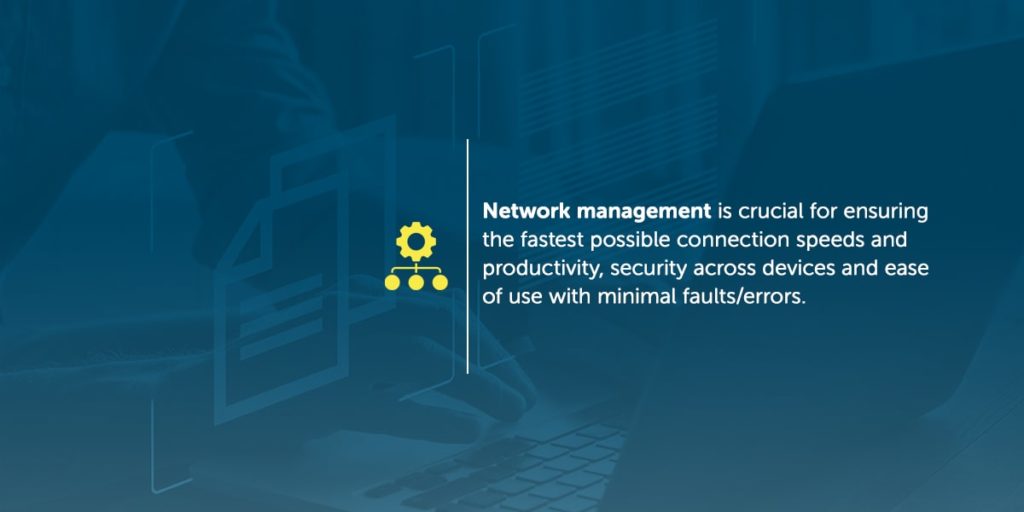
Why is Network Management Important?
Network management is highly important for any individual, company or business that uses the internet. Network management is crucial for ensuring the fastest possible connection speeds and productivity, security across devices and ease of use with minimal faults/errors. With the rise of the cloud, remote jobs and Bring-Your-Own-Device (BYOD) work models, ensuring that networks are running smoothly and securely is more important than ever before.
Most of the networks that are still operating today were created long before current cloud models and BYOD were in wide practice. As such, network administrators are having to come up with creative ways to keep their networks running as best as they possibly can. With more users connecting via the cloud and from personal devices, good network management is key to ensuring that users have seamless, secure access to the network.
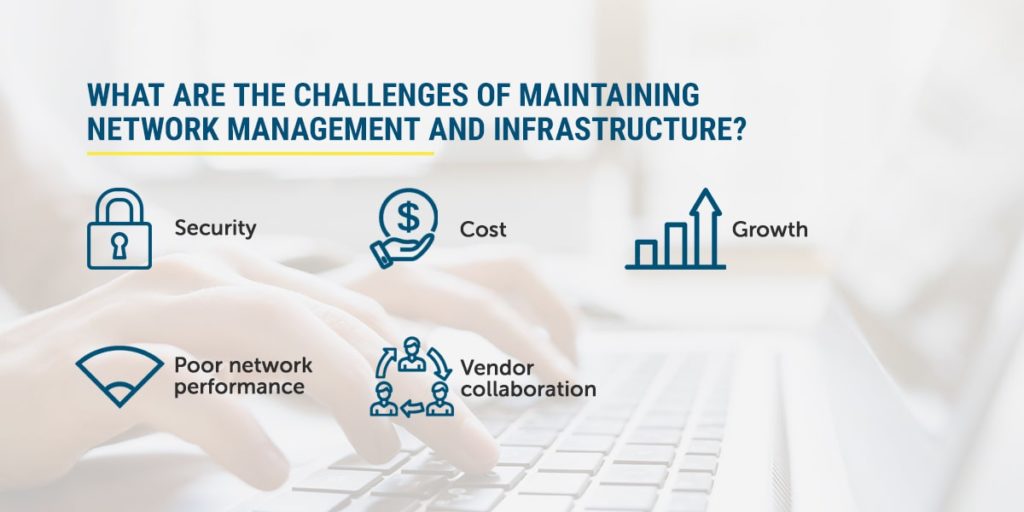
What are the Challenges of Maintaining Network Management and Infrastructure?
One of the primary changes faced by network administrators today is the increasing complexity of the networks themselves. Network administrators must grapple with the complexities of the networks with which they work, in addition to many other challenges, included but not limited to the following:
- Security. As stated, with the rise of remote work and BYOD practices in the workplace, not to mention the presence of smartphones and other personal devices, networks are no longer held by traditional boundaries or physical locations as they were in the past. Today, network administrators must deploy additional strategies to protect data and eliminate threats. Network management can effectively monitor potential attacks on the network and ensure that security tools are working together to maintain network speeds and traffic while also securing user data.
- Cost. The cost of maintaining healthy, productive and secure networks will nearly always exceed a business or company’s IT needs, including network management. Now, with the rise of remote work, video conferencing and BYOD, networks require additional levels of reliability and quality. As such, there is more work than ever for network administrators, and this is reflected in the rising cost of network management.
- Growth. Networks continue to expand in terms of both reach and the number of connected devices. As more and more devices connect to the network, the strain on the network itself will also increase. As a consequence of this increased connectivity and growth of networks, network managers face the additional challenge of managing rapid growth while also performing all other duties relating to security and troubleshooting of the network.
- Poor network performance. Perhaps the most obvious challenge posed to network management, poor network performance is the single most important and impactful issue with which network administrators must grapple. As a consequence of the aforementioned growth and overall increase in network traffic, poor network performance is faced by network administrators across industries and companies. Network management must address this challenge before it can address any of the other challenges. It is a consequence of many of the other challenges, such as security concerns, growth and cost, that have previously been mentioned.
- Vendor collaboration. As networks continue to grow and expand in completely new and rapid ways, a business or company’s ability to continue collaborating with vendors is likely to be a challenge. Both software and hardware that was state-of-the-art within the past year or two may now be considered out-of-date. Network management teams must understand how they can continue to work with old, existing programs and systems in order to maintain their networks.

Best Practices for Network Management
The exact practices of each network and its network management team will vary based on the specific size, scope and needs of the network in question. Some of the most effective best practice for network management can include the following:
- Understand the network. The more that a network administrator or network management team understands the network and its baseline for operating, the better network management will be able to address any problems and security threats that may arise. An established baseline for the network is key for nearly every aspect of network management and can greatly contribute to network flexibility and adaptability.
- Create and enforce escalation protocols. Despite the best and most dedicated efforts of any network administrator and network management teams and systems, problems — from errors to speed issues to security breaches — are inevitable. It’s critically important that network management practices have escalation protocols in place for these problems when they arise. For example, having specific plans in place for resolving different types of issues is one way in which escalation protocols can assist in the entire troubleshooting process.
- Layered breakdowns. Layered breakdowns are an invaluable feature that can be applied and maintained by many different network management systems. Essentially, with layered breakdowns, the network management system is able to collect information about every layer of the network, from physical cables and wires to IP addresses to connectivity issues to transport protocols. Wth this feature in place, network administrators are better positioned to pinpoint the exact source of problems within the network.
- Failover protections. As network management systems and/or network administrators work to troubleshoot and then to resolve issues, there is a risk that the entire network can go offline or crash during the process. This can result in loss of data and, of course, interrupts productivity until the network is back online. Failover protections are a kind of fail-safe that all network management systems should have in place in order to prevent those kinds of network outages from occurring.
- Planning for growth. As is true with nearly every aspect of business, the capacity for network growth is a critical indicator of the potential for success of the business or company as a whole. Network management systems and the individuals who work as network administrators should always be looking for ways in which they can pursue growth opportunities and investments in new technologies and network systems.
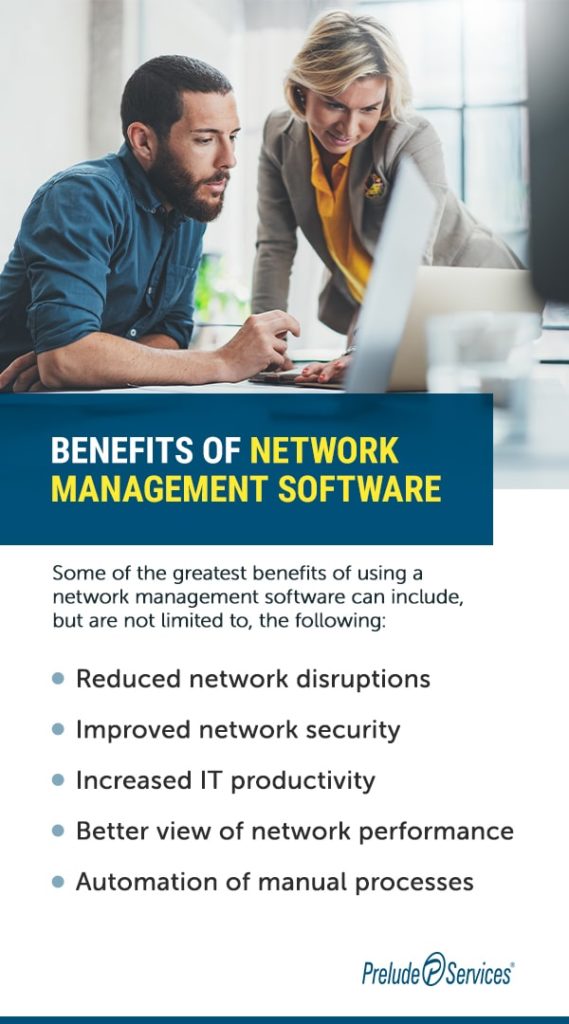
Benefits of Network Management Software
It will always be important to invest in skilled, competent IT professionals to work as network managers and network administrators. Today, there are also several different types of network management softwares that can assist IT professionals, and network administrators in particular, to monitor and manage the networks with which they work on a daily basis. Some of the greatest benefits of using a network management software can include, but are not limited to, the following:
- Reduced network disruptions. Thanks to the innovative nature of many network management and/or network monitoring systems, it is easier than ever before to reduce network disruptions. Network monitoring systems are able to reduce these disruptions by employing clear, easy-to-understand predictive technology. This technology can help IT professionals and network administrators to identify more quickly the source of a network disruption, as well as how to resolve these disruptions as they arise.
- Improved network security. Network management systems are able to provide 24/7 monitoring to a level that human network administrators are simply not able to achieve without assistance. As such, IT teams can expect much greater security for their data and overall network when they rely on the security capacity of a network management system.
- Increased IT productivity. With the assistance of network management software, IT professionals, including network administrators, are better positioned to increase their own productivity. Network management systems automate many of the basic network monitoring systems, freeing up the IT team to work on more pressing issues. In this way, the network management system can save a business both time and labor costs, while increasing productivity and reducing employee stress.
- Better view of network performance. Network management systems are able to collect information and data across all levels of the network. These systems can give an unprecedented level of insight into the daily workings and performance of the network as a whole. With these insights, network administrators are able to analyze the data to make predictions about future performance, as well as identify opportunities for network growth and potential investments into new technology and infrastructure.
- Automation of manual processes. Network management systems can allow IT professional teams, including network administrators and managers, to automate many of the rote and tedious manual processes that take up significant time and energy. Some of these manual processes include network inventory and assessments, mapping, wire tracing, configuration backups and remote access to the network infrastructure. Once a network management system automates these and other processes, the entire network will likely operate more smoothly and streamlined, with less interruptions and security breaches.
Why Your Business Should Evaluate Network Management Services
For most of the industries and businesses of today, there are innumerable benefits for investing in network management, and in particular, network management services. Nearly every business can expect to see both financial returns and increased productivity when they invest in meaningful network management services. When evaluating network management systems, it can be helpful to think about the exact challenges that your business wants the network management system to address and/or mitigate. By asking yourself the following questions, you can understand better how network management systems resolve problems and challenges which your business is facing.
Can the system automate manual processes?
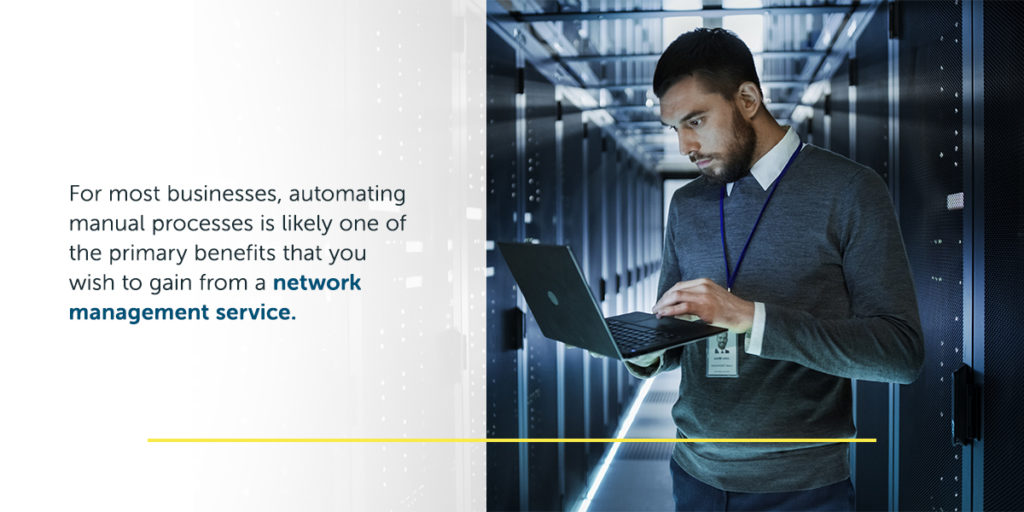
CAN THE SYSTEM AUTOMATE MANUAL PROCESSES?
For most businesses, automating manual processes is likely one of the primary benefits that you wish to gain from a network management service. When asking yourself this question, it can be helpful to identify the most tedious processes currently faced by your team. If your current network management service is not addressing this challenge, it may be time for your team to upgrade your system, and/or invest in an automation-forward system in the first place.
CAN THE SYSTEM GIVE MEANINGFUL INSIGHT INTO THE NETWORK AND ITS OPERATIONAL CAPACITY?
In addition to automation, IT professionals and network administrators will be most interested in network management systems that can provide real-time, comprehensive insights into the network and how it operates on a daily basis. With these insights, tasks like troubleshooting, isolating errors and resolving network issues can be completed with more ease than ever before.
CAN THE SYSTEM SUPPORT DIFFERENT VENDORS?
Depending on the type of business/company with which you work, the importance of vendor support may vary, in terms of network management and network management systems. For some businesses, vendor support is critical to their ability to do business successfully. Vendor support can be made much simpler and more comprehensive with the use of the right network management system.

CAN THE SYSTEM INTEGRATE DIFFERENT TOOLS?
Like vendor support, the level to which integration of different tools into the network is important will vary from business to business. For some businesses, this component of the network management system will be crucial to their daily operations. Network administrators should carefully evaluate what tools they need to use on their network and which network management system(s) will best allow them to do so.
DOES THE SYSTEM HAVE A PROVEN RECORD OF REDUCING COSTS?
As previously stated throughout the article, one of the biggest challenges to network management is the sheer cost. As such, network administrators and network management teams should not shy away from interrogating how, exactly, a network management system will save them money and help them to stay at or under the allotted budget.

Trust Prelude Services with All of Your Network Management Needs
Prelude Services specialize in innovative, secure IT solutions to the healthcare industry. Prelude is proud to assist healthcare organizations by securing their data, streamlining their networks and providing the highest quality of customer service. Your organization’s IT needs will always be their top priority.
Prelude Services technologies are specifically tailored to the needs of senior living and care organizations. Currently, they provide IT support to over 700 senior living, long-term care, affordable housing and community service facilities throughout the country. Prelude is able to offer the most innovative technologies, along with a comprehensive understanding of HIPPA and the unique needs faced by the long-term care and senior living healthcare markets. Contact Prelude Services today to request more information about their dynamic IT solutions.
CONTACT PRELUDE SERVICES FOR 24/7 IT SUPPORT
Technology has become a crucial part of the modern business experience. Without functional computers and mobile phones, many business practices would grind to a halt. Unfortunately, breakdowns and malfunctions are an inevitable part of any machine, meaning businesses do grind to a halt until the issues are fixed. In order to keep your business running, it's crucial to have access to IT support when you experience technical difficulties.
If you're a healthcare company, long-term care provider, or small business in need of IT support at all hours, consider Prelude Services. We're a SSAE SOC
Compliant business dedicated to improving your security and functionality. We offer specific IT services for senior living care, nursing homes, retirement home services and assisted living, including 24/7 IT support. If you want to know how Prelude can help you, contact us today!
